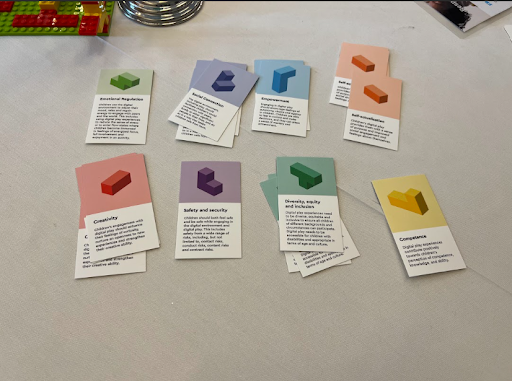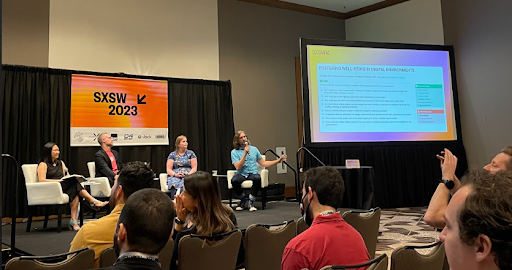Where were all the influential tech and media companies hanging out in early March? They were all at SXSW 2023— and so was the Cooney Center! We’re back from an amazing few days of hanging out in Austin with innovators who are shaping our future, and are thrilled to share some of our highlights from an incredible few days here.
With two panels and a very popular LEGO Play Lounge during the conference’s Design Track, the Cooney Center, in collaboration with the LEGO Group, the LEGO Foundation, the Fair Play Alliance, and Riot Games, was able to reach a wide swath of designers with messages about the importance of thoughtfully creating digital spaces that contribute to the thriving of both kids and adults.

At the Designing Tech for Children’s Well-Being panel, speakers shared learnings, resources, and advice from the Responsible Innovation in Technology for Children (RITEC) initiative founded by the LEGO Group and UNICEF and supported by the LEGO Foundation.
Cooney Center Executive Director Michael Preston described how RITEC partners UNICEF and Western Sydney University conducted research with children to develop a framework with eight well-being outcomes: competence, emotional regulation, empowerment, social connection, creativity, safety and security, diversity, equity and inclusion, and self-actualization.
Jan Plass, from NYU’s Create Lab, walked the audience through how his team is testing the framework by having children play specially selected games and measuring their well-being responses. Elizabeth Milovidov explained why the LEGO Group, a toy company, is interested in exploring how to create safe, positive digital play experiences for children (“because that is where kids are!”). And Jen Kotler from Google’s Kids and Family Team described how she uses the well-being framework, or “the RITEC Eight” as she calls it, to check that the products that her team is developing are aligned and incorporate elements like empowerment and creativity.
When asked what advice they would give the designers in the room, Jan said, “The first step is awareness. And the best place to start would be to look at the [RITEC] framework and all the different facets of what well-being could look like and what that would mean to you as a designer.”
Elizabeth flipped the question, asking designers for their help:
“You, the designers and the digital designers. It’s just amazing the power and the strength that’s in this room to help us all figure it out,” she said. “By creating something where digital well-being is already integrated, well-being by design is already there, it becomes easy to say, oh yeah, well, this is great. My child is going to feel better when they get off. My child will have agency. My child will have competence when they close their screen or shut down that game.”

In the Designing for Digital Thriving panel, Riot Games, Blizzard, Fair Play Alliance, IDEO and the Cooney Center came together to address the question: How can we create & foster healthy, inclusive digital spaces that enable individuals and communities to thrive? As we spend more and more time in digital spaces, whether it’s on our phones, in Zoom meetings, or streaming our favorite games or tv shows, we need to collectively find a way to make these spaces safer and allow for all individuals to be their authentic selves both in life and online.

While we know this won’t be solved overnight, we do know where we can start, and that’s with games. Weszt Hart and Natasha Miller, executive steering committee members of the Fair Play Alliance, spoke at length about why games are a great roadmap for all other industries when it comes to figuring out how to design with digital thriving in mind.
Natasha, who is a Senior Research Scientist at Blizzard Entertainment, talked about how behavior is a product of people and their environment— and in games, we can control the environment. “Because we can have complete control, we’re able to actually measure impact, making games the ideal space to measure to know whether or not we are effective at enacting change,” said Natasha. Weszt, Head of Player Dynamics at Riot Games, added that what makes games so valuable is the richness of the medium. “It’s more than just playing games,” said Weszt. “Since playing games is a holistic experience, we believe games offer the greatest opportunity to solve the greatest number of problems for the greatest number of people.
Michael Preston discussed the lessons that games can teach all of us regardless of industry. Games are played by 3 billion people globally, and we know the vast majority of kids play games, so it’s a fantastic way to reach them,” said Michael. “But before we can reach them we need models for the field that can translate this work into practice.”
More information about the Designing for Digital Thriving work can be found here.
We wrapped up our time at SXSW with our heads filled with thoughtful questions and ideas from the designers we spoke with. We are inspired by the creative energy of all those we met who are working to build new things. We are looking forward to incorporating all that we’ve learned into our work to provide designers with tools and resources to help them create with children and adult well-being at their heart.
Watch the Designing Tech for Children’s Well-Being panel here:
Watch the Designing for Digital Thriving panel here:


